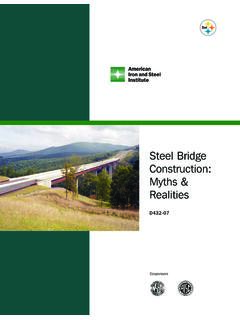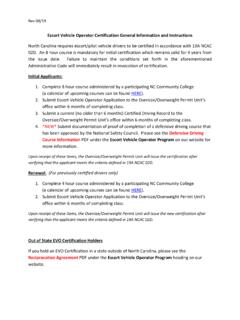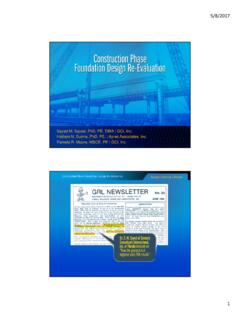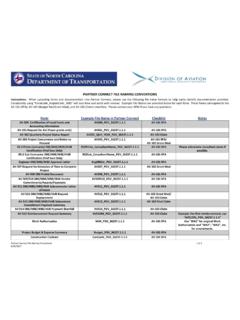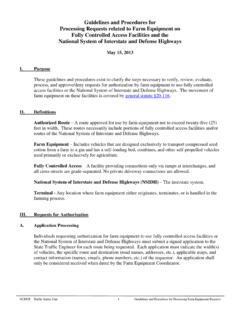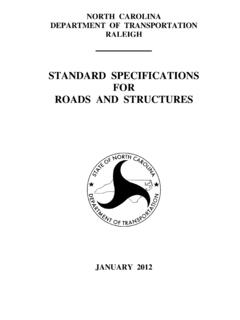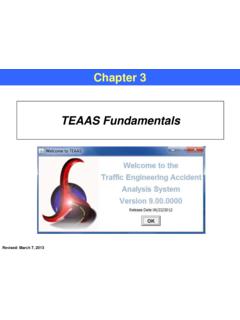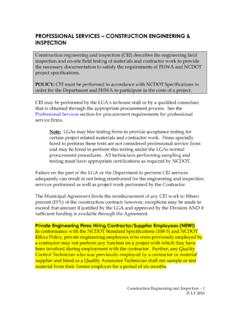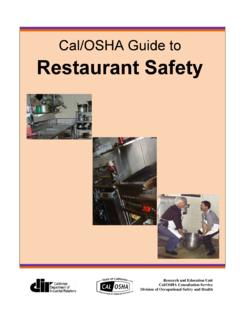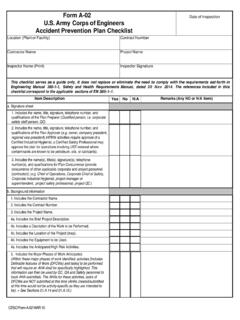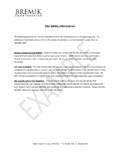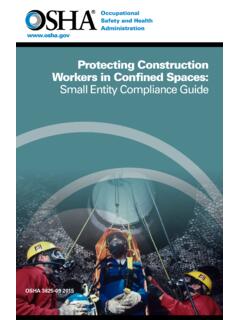Transcription of EMERGENCY ACTION PLAN & FIRE PREVENTION PLAN
1 CHERIE K. BERRY JOHN R. BOGNER, JR. COMMISSIONER CONSULTATIVE SERVICES BUREAU CHIEF DIVISION OF OCCUPATIONAL SAFETY AND HEALTH EMERGENCY ACTION PLAN & FIRE PREVENTION PLAN WELCOME! This sample program is provided to assist you as an employer in developing programs tailored to your own operation. We encourage you to copy, expand, modify and customize this sample as necessary to accomplish this goal. This document is provided as a compliance aid, but does not constitute a legal interpretation of osha Standards, nor does it replace the need to be familiar with, and follow, the actual osha Standards (including any North Carolina specific changes.) Though this document is intended to be consistent with osha Standards, if an area is considered by the reader to be inconsistent, the osha standard should be followed. Of course, we welcome your comments and feedback!
2 The North Carolina Department of Labor OSH Consultative Services Bureau can be contacted for further assistance such as helping you set up your individual program and even with on-site surveys. Feel free to contact us at 1-800-NCLABOR or at 919-807-2899. You may also want to visit our website at Remember: A written safety/health program is only effective if it is put into place! 4 WEST EDENTON STREET. RALEIGH. NORTH CAROLINA 27601-1092 (919) 807-2899 FAX (919) 807-2902 _____ (Company Name) EMERGENCY ACTION PLAN (Ref: ) INTRODUCTION: This document is a plan to prepare for workplace emergencies. By auditing the workplace, training employees, obtaining and maintaining the necessary equipment, and by assigning responsibilities, human life and company resources will be preserved. The intent of this plan is to ensure all employees a safe and healthful workplace.
3 Those employees assigned specific duties under this plan will be provided the necessary training and equipment to ensure their safety. This plan applies to emergencies that could be reasonably expected in our workplace such as fire/smoke, tornadoes, bomb threats, leaks, etc. EMERGENCY PLAN COORDINATORS: Building/Department Name/Title Phone # Coordinators are responsible for the proper inventory and maintenance of equipment. They may be contacted by employees for further information on this Plan. PLAN OUTLINE/DESCRIPTION: I. Means of Reporting Emergencies: All fires and emergencies will be reported by one or more of the following means as appropriate: a. Verbally to the Coordinator during normal working hours. b. By telephone if after hours/weekends. c. By the building alarm system. Note: The following numbers will be posted throughout the facility: FIRE: _____ POLICE: _____ AMBULANCE: _____ II.
4 *Alarm System Requirements: Alarm system requirements for notifying employees during an EMERGENCY are as follows: a. Provides warning for safe escape. b. Can be perceived by all employees. c. Alarm is distinctive and recognizable. d. Employees have been trained on the alarm system. e. EMERGENCY phone numbers are posted. f. EMERGENCY alarms have priority over all other communications. g. Alarm system is properly maintained. III. Sounding The Alarm: The signal for immediate evacuation of the facility will be _____. The alternate means of notification will be_____. IV. Evacuation Plans: EMERGENCY evacuation escape route plans (see Appendix A) are posted in key areas of the facility. All employees shall be trained on primary and secondary evacuation routes. V. Employee Accountability: In the event of an evacuation, all occupants shall promptly exit the building via the nearest exit.
5 Go to your designated assembly point and report to your supervisor. Each supervisor (or designee) will account for each assigned employee via a head count. All supervisors shall report their head count to _____ who will be located at _____ and accessible via cell phone # _____. VI. Building Re-Entry: Once evacuated, no one shall re-enter the building. Once the Fire Department or other responsible agency has notified us that the building is safe to re-enter, then personnel shall return to their work areas. VII. Hazardous Weather: A hazardous weather alert consists of _____. When a hazardous weather alert if made, all employees shall immediately report to the closest tornado refuge area (see Appendix A). Stay in this area until given the all-clear sign which is a _____. VIII. Training: The personnel listed below have been trained to assist in the safe and orderly EMERGENCY evacuation of employees.
6 Task Building/Department Name/Title/Phone# Fire Extinguisher/Hoses Evacuation Assistant EMERGENCY Shut-down Employee training is provided when this plan is initiated, when employees required responsibilities change, when the plan changes, initially for new hires, and annually for all employees. Subjects to be covered include: a. EMERGENCY escape procedures/routes b. Fire extinguisher locations and proper use c. Head count procedures d. Major facility fire hazards e. Fire PREVENTION practices f. Means of reporting fires/emergencies (use of alarm systems) g. Names/titles of Coordinators h. Availability of the plan to employees i. Housekeeping practices j. No smoking areas k. Hazardous weather procedures l. Special duties as assigned to Coordinators and those listed above.
7 Written records shall be maintained of all EMERGENCY ACTION Plan training. *For further information on Employee Alarm Systems, see _____ (Company Name) FIRE PREVENTION PROGRAM (Ref: ) TABLE OF CONTENTS I. POLICY .. 1 II. CLASSIFICATION OF FIRES .. 1 III. DETERMINING FIRE hazards .. 2 OXYGEN-ENRICHED ATMOSPHERES .. 3 INDUSTRIAL TRUCKS ..3 IV. STORAGE AND HANDLING REQUIREMENTS..3 A. ORDINARY COMBUSTIBLES ..3 B. FLAMMABLE MATERIALS.. 4 V. POTENTIAL IGNITION A. WELDING AND CUTTING .. 5 B. OPEN FLAMES..6 C. STATIC ELECTRICITY .. 6 VI. HOUSEKEEPING PREVENTIVE TECHNIQUES .. 7 VII. FIRE PROTECTION EQUIPMENT ..8 VIII. APPENDIX A FIRE PREVENTION APPENDIX B INSPECTION LOGS AND FIRE INCIDENT . APPENDIX C IDENTIFIED FIRE hazards AND RESPONSIBLE APPENDIX D TRAINING RECORD.
8 14 APPENDIX E FIRE EXTINGUISHER FIRE PREVENTION PLAN I. Policy Established (date) (Executive officer) It is the policy of to provide to employees the safest practical workplace free from areas where potential fire hazards exist. The primary goal of this fire protection program is to reduce or eliminate fire in the workplace by heightening the fire safety awareness of all employees. Another goal if this plan is to provide all employees with the information necessary to recognize hazardous conditions and take appropriate ACTION before such conditions result in a fire EMERGENCY . This fire PREVENTION plan complies with the requirements of 29 CFR This plan details the basic steps necessary to minimize the potential for fire occurring in the workplace.
9 PREVENTION of fires in the workplace is the responsibility of everyone employed by the company but must be monitored by each supervisor overseeing any work activity that involves a major fire hazard. Every effort will be made by the company to identify those hazards that might cause fires and establish a means for controlling them. The fire PREVENTION plan will be administered by who will compile a list of all major workplace fire hazards , the names or job titles of personnel responsible for fire control and PREVENTION equipment maintenance, names or job titles of personnel responsible for control of fuel source hazards and locations of all fire extinguishers in the workplace. The plan administrator, or safety officer, must also be familiar with the behavior of employees that may create fire hazards as well as periods of the day, month, and year in which the workplace could be more vulnerable to fire.
10 This fire PREVENTION plan will be reviewed annually and updated as needed to maintain compliance with applicable regulations and standards and remain up-to-date with the state of the art in fire protection. Workplace inspection reports and fire incident reports will be maintained and used to provide corrections and improvements to the plan. This plan will be available for employee review at any time during all normal working hours. II. CLASSIFICATION Fire is a chemical reaction involving the rapid oxidation or burning of a fuel. It needs four elements to occur as illustrated below in the tetrahedron. This is described by the following illustration: Page 1 Heat Oxygen Fuel Chemical Reaction The first component of the tetrahedron is fuel. Fuel can be any combustible material such as: solid (such as wood, paper, or cloth), liquid (such as gasoline) or gas (such as acetylene or propane).
